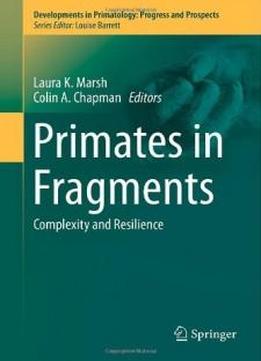
Primates In Fragments: Complexity And Resilience (developments In Primatology: Progress And Prospects)
by Laura K. Marsh /
2013 / English / PDF
12.5 MB Download
This book is number two in a series for Primates in Fragments. In
this volume, ten years after the first, we continue to address
issues regarding primates within a fractured landscape. There are
seven sections based on specific categories of primates in
fragments. In the Introductory section, authors discuss the issues
surrounding primates in remnant habitats as well as encourage
discussion about what we mean by fragmentation on a landscape
scale. In the Long-Term and Regional Studies section, authors
present information on changes that have occurred during longer
studies as well as changes that have occurred over regions. In the
Landscape, Metapopulations and the Matrix section, authors cover
topics from dry to moist forests, and from metapopulations to
single species use of multiple fragments locations. In Feeding and
Behavioral Ecology, authors take a closer look at the flexibility
and responsiveness of primates in fragments in terms of their food
choices, resource use, and behavioral changes. In Endemic,
Endangered, and Nocturnal Primates authors uncover details
involving critical primates living in major city centers to the
heights of the Himalayas. In Genetics, Disease and Parasites
authors cover topics including population viability, disease and
parasite transmission between primates in fragments and humans.
Finally, in the Conservation and Ecology: Threats and Management
section, we synthesize information in this volume and make
recommendations for the future of work in this field and the
survivability of primates in fragments.
This book is number two in a series for Primates in Fragments. In
this volume, ten years after the first, we continue to address
issues regarding primates within a fractured landscape. There are
seven sections based on specific categories of primates in
fragments. In the Introductory section, authors discuss the issues
surrounding primates in remnant habitats as well as encourage
discussion about what we mean by fragmentation on a landscape
scale. In the Long-Term and Regional Studies section, authors
present information on changes that have occurred during longer
studies as well as changes that have occurred over regions. In the
Landscape, Metapopulations and the Matrix section, authors cover
topics from dry to moist forests, and from metapopulations to
single species use of multiple fragments locations. In Feeding and
Behavioral Ecology, authors take a closer look at the flexibility
and responsiveness of primates in fragments in terms of their food
choices, resource use, and behavioral changes. In Endemic,
Endangered, and Nocturnal Primates authors uncover details
involving critical primates living in major city centers to the
heights of the Himalayas. In Genetics, Disease and Parasites
authors cover topics including population viability, disease and
parasite transmission between primates in fragments and humans.
Finally, in the Conservation and Ecology: Threats and Management
section, we synthesize information in this volume and make
recommendations for the future of work in this field and the
survivability of primates in fragments.











